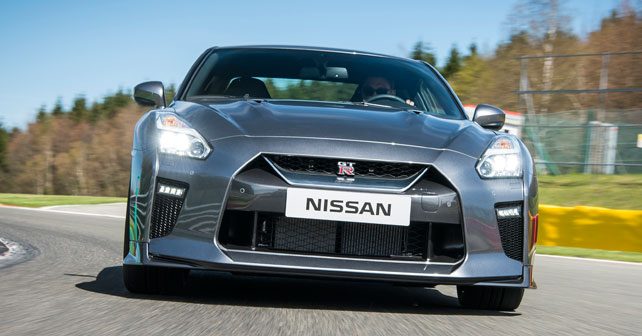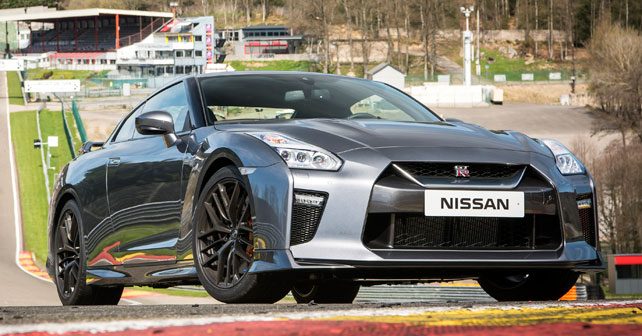To become a true GT-R convert, Dhruv had to take Godzilla by the horns – at Spa, in the pouring rain! Frankly, there was no telling how this would end up…
Whenever we’ve tested the Nissan GT-R before – specifically at the Dubai Autodrome many years ago, and more recently at the Buddh International Circuit – we’ve used phrases such as ‘neck-snapping acceleration,’ or ‘face distorting grip levels’ in an attempt to describe the many ways in which Godzilla can alter your anatomy when prodded. Well, the Nissan engineers appear to have taken pity on us lily-livered motoring hacks and potential customers by adding a few more doses of civility into the 2017 GT-R. Godzilla, it seems, has been squeezed into a tux!
Just as well I suppose, since Nissan is finally on the verge of launching its long-time halo car in India. And, of course, while we love being shoved into our seatbacks we don’t mind keeping our tooth fillings in place at the same time – as we attempt to circumnavigate the pothole-ridden surfaces masquerading as roads in the majority of our cities.
So, the first thing that you notice as you approach the GT-R is that it has a slightly friendlier face and a far more opulent cabin – not to mention driving manners that are a lot more civil around town and on the highway. Our orange test car even had a matching interior with swathes of Napa leather to ensure that every surfaces we touched was as smooth as a baby monster’s bottom – well, it is still Godzilla at the end of the day.
But it has to be said that the leather stitching on the dash, centre console, and door panels completely transforms the cabin. While, in the past, you would simply tolerate its boot camp interior because this machine did what it did when pushed, you no longer have to make any excuses whatsoever when seated in the cabin. In fact, the seats are surprisingly comfortable on long blasts down the Autobahn – and the boot is big enough for more than a couple of bags. It appears, then, that Nissan is finally taking the ‘GT’ portion of its name – Gran Turismo, or grand touring car – seriously.
Don’t for a second, however, think that the GT-R has gone soft. Sure, the ride is far more compliant in ‘Comfort’ (in fact, the improvement in ride quality is the most positive change in my book), and the sound levels in the cabin are much reduced, but let’s take a slightly more detailed look at some of the changes to the 2017 model – shall we? Let’s start with the V in the bonnet. At first glance you may think that this has been done to make the GT-R look less aggressive and more disarming. But mention that to the Nissan engineers and they simply laugh. No, they say, they haven’t made any changes for the sake of “entertainment” – they consider styling ‘entertainment’ obviously. “No, we’ve redesigned the front end to provide more downforce between 250-300km/h,” says an engineer very matter-of-factly. This, of course, means that you’re not really getting your money’s worth unless you’re doing over 250km/h.
Perhaps this is why Nissan India brought a bunch of us to Germany to test the new GT-R on some unrestricted stretches of Autobahn, as well as – and this was the piece-de-resistance – on the legendary Spa Francochamps circuit in Belgium. The Nissan engineers have, of course, added more power – 20 horses worth – as well as vastly improved the torque curve by providing better cooling. They’ve also cleaned up the C-pillars slightly and borrowed the tail from the previous generation NISMO GT-R (NISMO is Nissan’s racing division) to clean up the airflow and turbulence coming off the car to improve aerodynamic efficiency. So, bear in mind – with power upgrades, added creature comforts, and aerodynamic gains – this is more than just a mere facelift.
We flew into Dusseldorf, and the plan was to pick up the cars from the airport and take the long way to Spa, which would give us two-and-a-half hours worth of Autobahn time – as well as the chance to carve through some country roads before we got to the track. The problem, however, was the weather. Not only was it quite miserable on account of constant rain, but the visibility in some cases didn’t stretch beyond a couple of metres at best. Still, these are conditions that the GT-R revels in. All-wheel drive means that traction is immense, even in the worst conditions. And with the added power and improved torque, it was a case of absolute power on demand. You merely had to think about pressing on, and the GT-R would leap forward in response. What about turbo lag from the twin turbos, you ask? Well, the Nissan engineers would have none of it. The phrase ‘turbo-lag’ is no longer in their lexicon it appears.
Each GT-R motor is assembled by hand by master craftsmen – they’re known as Takumi Masters – and even the engineers speak of them in reverential hushed tones. The GT-R Chief Engineer is an intense, but funny, man (read: genius) by the name of Tamura San. And to fully get the GT-R, you have to sit down with him over a beer to get some sense of the level of detail and excellence that goes into each and every engineering decision in this car. Oh, and by the way, there are only engineering decisions here – remember, to alter something simply for its appearance would be ‘entertainment’ after all! This is also prevalent when you try and use the nav system or stereo, which you soon discover is quite hopeless.
But we’re not here to fiddle with the on-board entertainment. We’re here to toggle all the drive systems to their extreme setting and tackle the famous Eau Rouge corner – which was once the most challenging corner in Formula 1. Modern F1 cars generate so much downforce that the drivers now simply keep the throttle pinned while they weave through this blind left-right-left that leads you deep into the Eifel mountains.
When we arrive at Spa, we’re told the track is closed because of the weather conditions. The wet track the GT-R can handle, but the visibility means that its weakest link – the driver – is even more handicapped than ever. Fortunately, after about an hour or so, the conditions improve enough for the Nissan team to let us onto the track with a great deal of trepidation. Fortunately also, we each have a professional racing driver sitting alongside telling us exactly where to go even in near zero visibility at times.
We set off from behind the outside wall of the famous La Source hairpin, and head straight towards Eau Rouge – which, the first time you approach it, feels like you’re attempting to drive up a brick wall. It’s that steep – something that you just don’t pick up on in videos and pictures. The instructor actually had to put his hand on the steering and guide me through the corner the first time, because you’re literally driving blind. And, in these conditions especially, you really have to be careful when and where you begin to put the power down. After a couple of laps I was starting to get more comfortable and tried to put the power down a little early – not a good idea, as the car squirmed immediately because the road just seems to wash away from you as you approach the top of the hill. It’s really only once you’re on the Kemmel straight that you can really floor it. You then race towards Les Combes, before you approach the never-ending series of bends as the road drops down once again. Once you negotiate the likes of Pouhon and Stavelot you come up to the blindingly fast Blanchimont and then finally to the Bus Stop chicane and the F1 straight.
It’s all quite overwhelming the first time around, especially in these conditions. But, honestly, if there was one car that I had to choose in which to do it in it would be this one. In an age of electric steering systems that are completely devoid of feel, the GT-R retains a hydraulic steering rack that picks up the actual texture of the road beneath you. The all-wheel drive system, meanwhile, is completely unflappable while the traction control systems allow you a little leeway before cutting in. The thing is, though, that the chassis is so balanced and the tyres have so much grip that the traction control never really has to intervene – even in these conditions. The power delivery is still savage, and the grip levels still mind-bending, but on this day, on this track, in these conditions, the GT-R finally starts to make sense to me. I have to admit that I didn’t fully get it before. But, after talking with Tamura San, and understanding the sheer level of precision that they’re chasing, and experiencing the GT-R at Spa in the pouring rain, I get it now.
With this update, they’ve gone for more performance and more refinement – and that’s exactly what they’ve achieved. I have to admit that this is one of the best machines that I’ve sampled in my entire life. Period.
Long live Godzilla!
Spa Francorchamps
Spa is one of those old-school legendary circuits that is steeped in the history of courageous victories. Fortunately, modern-day Spa retains all its charm and character even to this day. Eau Rouge is everything you expect it to be – and more! The rest of the circuit, nestled in the Eifel mountains, isn’t bad either. The Eifel mountains, of course, are home to another legendary track – the Nurburgring Nordschleife circuit. I’ve had the pleasure of driving at the ‘Ring’ several times in the past, but this was my first visit to Spa. And while it’s not quite as challenging as the ‘Green Hell,’ it’s a circuit that’s not only beautiful but also one that truly tests courage and skill. I can only hope that it remains a permanent fixture on the Formula 1 calendar.

Engine: 3,799cc / 6-Cylinders / Twin-Turbocharged / DOHC / Direct Injection Fuel: Petrol Transmission: 6-Speed Dual-Clutch / All-Wheel Drive Power: 562bhp @ 6,800rpm Torque: 637Nm @ 3,300–5,800rpm X-FACTOR: Godzilla has softened with age. Godzilla has also grown more motherly than ever - it simply makes you look like a better driver than you actually are!
Also read: Nissan GT-R Review











































Write your Comment